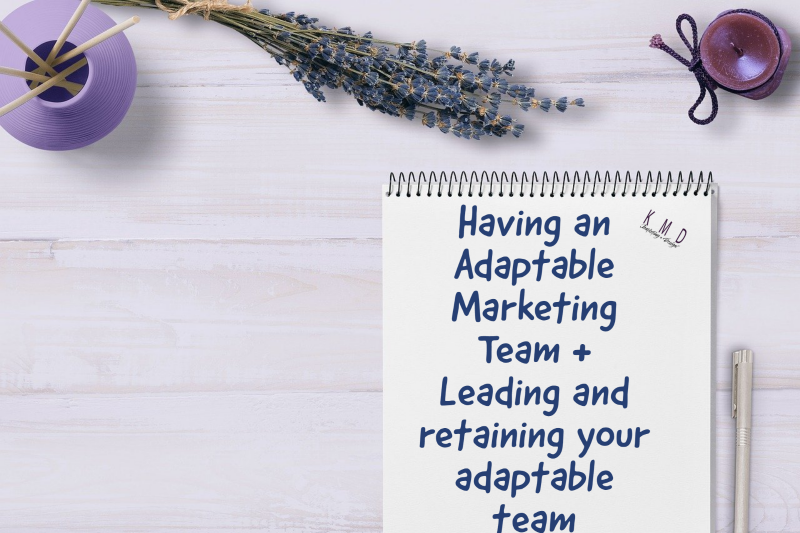
Having an Adaptable Marketing Team
Leading and Retaining Your Adaptable Team
From the life of being an entrepreneur to growing a team whether it is an internal marketing department, customer service, etc. – the definition of how to lead and retain your adaptable team varies. Remember that the most effective team leaders build their relationships of trust and loyalty, rather than fear or the power of their positions.
We’ve covered new marketing trends and built a team that can be adaptable through times of change. Now we need to cover how to lead and manage your team to maintain the best output and the most innovative response and adaptability. So, how do you build an agile team?
First, remote work. Many businesses have said the pandemic put on the accelerant for the greatest future of work experiment. And this is remote work. Many businesses were fully remote before the pandemic. Now more have joined the bandwagon. This was and still is one of the largest challenges for many businesses and managers. Now we need to learn how to manage a remote work environment. Research from the Creative Group found that 66% of workers who transitioned to remote work felt that their work-life balance has improved without a commute. You may have had a similar or different experience. Also, this model we know isn’t feasible for every business. Take retail and restaurants. Some roles need to be in person. Furthermore, 75% of professionals easily transitioned to remote work and can accomplish tasks remotely.
When we start to look at what the future is like. All of you have probably seen how various businesses made permanent changes to make remote work. Whether it be Google which announced they would only require up to 3 days a week or organizations that have moved to permanent remote work such as Microsoft. There also are businesses that have offered stipends for those that do work from home. In conclusion, most are going to go hybrid in the future or fully remote. When it comes to marketing and building an in-house marketing team it would be wise to ask those what they would like to do. You are going to have some that want to be full-time in an office, others may want a hybrid model and lastly, you will get ones who never want to return to an office. Considering what your employees want will help you gauge the future of your business model and how you retain top talent. Remote work is here in a broad way. Creating a plan that works for you and your team will be of value.
How do you lead and manage a remote workforce? Forging connections in a remote environment was thrust upon us in 2020. And so how managing this remote team can be tricky. But there is a need for it. Some examples to keep workplace culture alive while working remotely can be done by fostering connections. Zoom and other virtual video conferencing platforms have been instrumental to the success of a remote workforce to stay connected. Additionally utilizing other technologies such as storm box and other marketing collaboration tools like idea boards, whiteboards, etc. allows us to form connections. The use of instant messaging like Slack and Microsoft Teams keeps us connected on the fly when we can’t walk up to someone. Additionally, figuring out ways to celebrate wins, holidays, etc. need to be deliberate to keep the culture alive with dispersed teams.
4 Ways to Foster an Adaptable Team
Growth
Second is the importance of providing growth. Most employees have a hard time keeping their skills up to date. Not only providing professional growth resources for skill development is a valuable tool.
Collaboration
Creating a team for collaboration and culture to not only be able to really innovate but to provide great work products requires collaboration across teams. 42% said that improving collaboration outside of the marketing department would improve their overall transformation, output, and results.
Purpose
Purpose, mission, and drive have always been valuable. But today it is not only valuable but in order to do purpose-driven marketing strategies you need to engage your team in the purpose of their work as well to make sure they are connected to the company’s purpose, the department’s purpose, and the team’s purpose for the work they are doing and the goals and objectives. But also more broadly they are a contribution. Employees today definitely value the purpose of social mission as it relates to connecting to the core values of the business. Connecting to programs for diversity, equity, and inclusion as a leader we need to challenge ourselves that our team and business has this.
Compensation
Many businesses have seen changes not only in team sizes and staff levels but salaries may have been cut to retain employees or paused certain incentives. As we look to move forward restoring compensation levels not only raises morale but retention too. Keep in mind compensation is more than salary and bonuses. It might include stipends, reimbursement for professional development, and/or providing technology to set up remote work.
Those that build a team that is agile and adaptable are thriving. And as more businesses evolve to this way of doing business we will continue to see this. If the events of 2020 taught us anything it is that marketing and creative professionals not only had to but have successfully adapted to the changing circumstances. Additionally, it not only serves you and your business but it contributes to the greater extent of the future. Building and leading a marketing team requires adaptation. Adapting to new market trends. Adapting to new ways of hiring. Adapting to new ways of leading and managing our teams.
The full series of Having an Adaptable Marketing Team is Part 1, Part 2, Part 3, Part 4
Are you ready to take your marketing to the next level?
Take the online marketing questionnaire for when you need a little help getting your marketing efforts off the ground.







